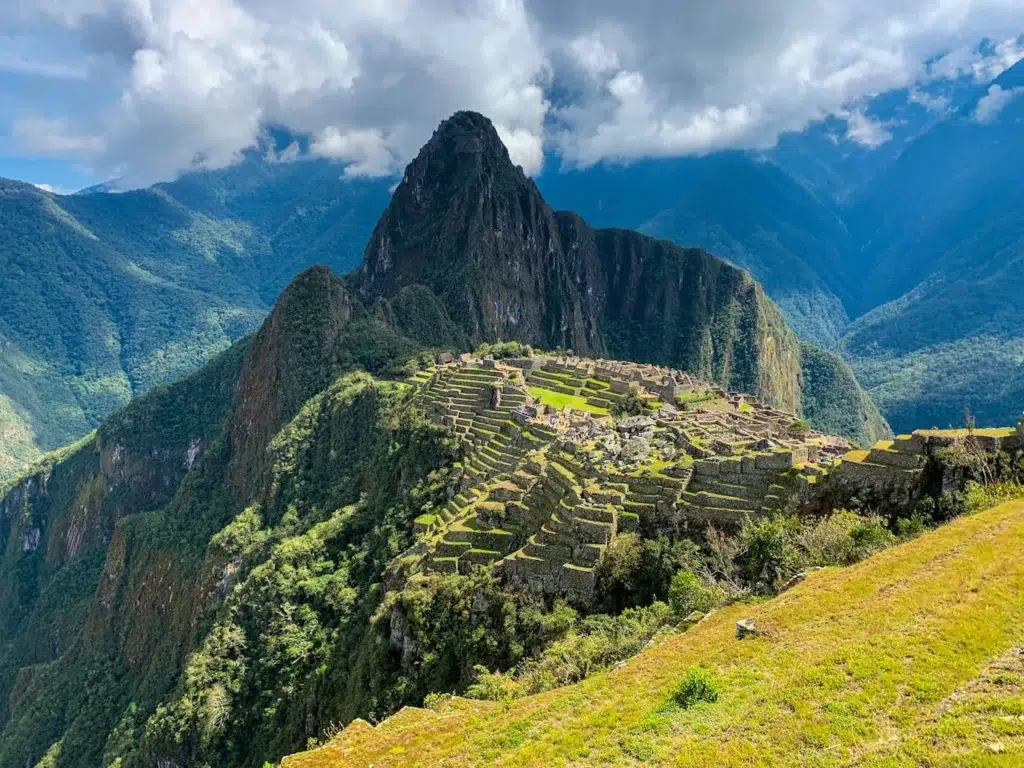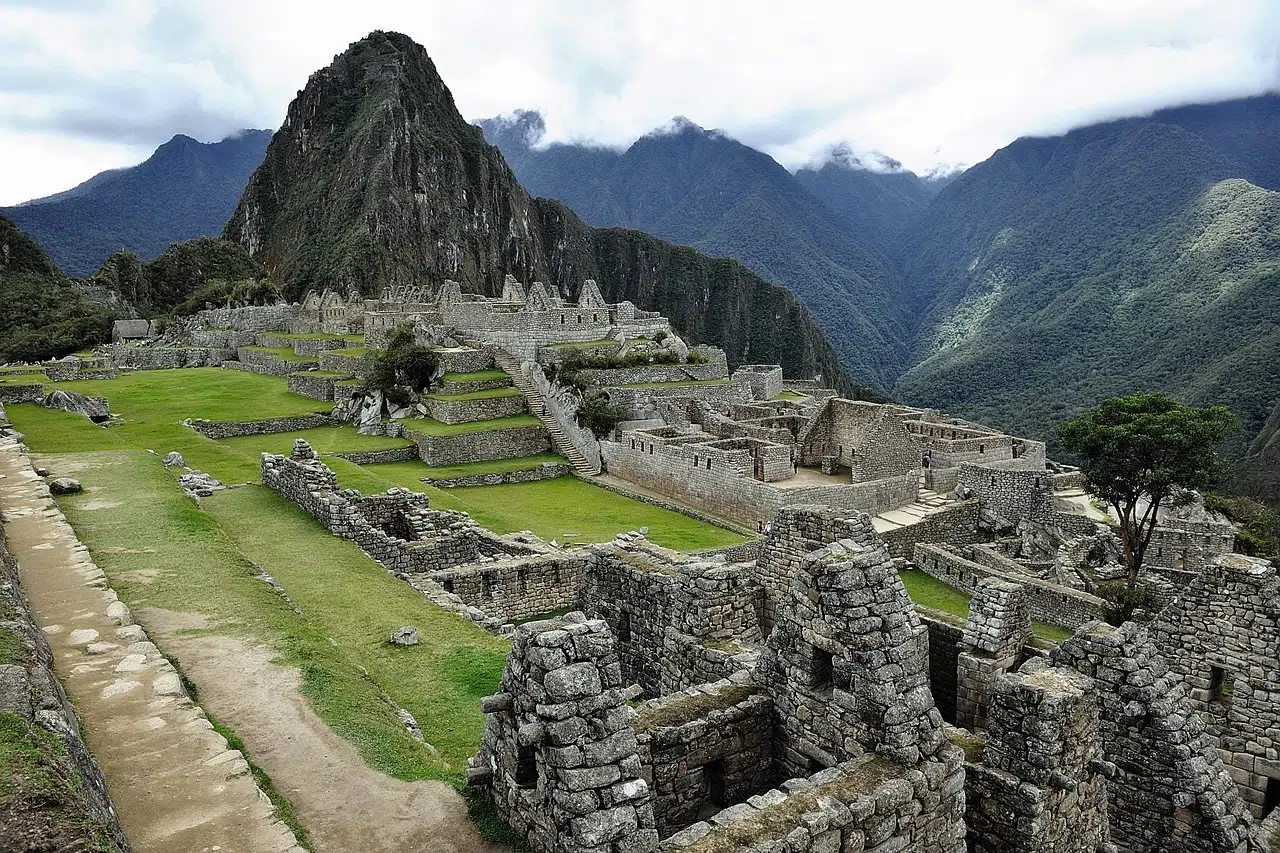Machu Picchu, one of the most iconic travel destinations in the world, is a place of mystery, history, and breathtaking landscapes. However, many visitors underestimate the impact of Machu Picchu weather on their trip. The Inca citadel is located in the Andean cloud forest, meaning it experiences a mix of subtropical, mountain, and rainforest climates.
Before booking your trip, understanding the weather at Machu Picchu is crucial for packing, hiking, and ensuring the best possible experience. This guide will provide a detailed breakdown of Machu Picchu’s weather by season, month, and time of day, helping you choose the best time to visit and prepare accordingly.
Tours in Machu Picchu
1. Where Is Machu Picchu and How Does Its Location Affect the Weather?
Machu Picchu is situated in southern Peru, in the Andean mountain range, at an altitude of 2,430 meters (7,970 feet) above sea level. Despite being in the mountains, its proximity to the Amazon Rainforest significantly influences its climate.
Unlike cities such as Cusco (3,400 m / 11,155 ft), which experiences colder temperatures due to its higher elevation, Machu Picchu has a milder and more humid climate. The two dominant seasons are the dry season (May to September) and the rainy season (November to March), each offering different experiences for visitors.
2. Machu Picchu Climate Overview: Dry vs. Rainy Season
Dry Season (May – September): The Best Time to Visit?
✅ Advantages:
- Clear skies and minimal rainfall
- Stunning panoramic views and great photography conditions
- Best time for hiking, including the Inca Trail and alternative routes
❌ Disadvantages:
- Colder nights and early mornings, especially in June and July
- High tourist crowds, particularly in June, July, and August
- Higher costs due to peak-season demand
The dry season is considered the best time to visit Machu Picchu for those looking for stable weather and ideal hiking conditions. However, it is also the busiest time, with larger crowds and higher prices for permits, accommodations, and train tickets.
Rainy Season (November – March): Should You Avoid It?
✅ Advantages:
- Fewer tourists and a more peaceful experience
- Lush, green landscapes perfect for photography
- Warmer temperatures in the mornings and afternoons
❌ Disadvantages:
- Frequent rain showers and cloudy conditions
- Risk of mudslides and landslides on trails and roads
- The Inca Trail closes in February due to heavy rains
While many travelers avoid Machu Picchu during the rainy season, some prefer the tranquility and vibrant green scenery. If you visit in November or March, you can often catch the transition periods when rainfall is less intense, making it a good alternative to the peak season.

3. Month-by-Month Breakdown: Machu Picchu Weather Conditions
Here’s what you can expect each month at Machu Picchu:
January & February (Wettest Months)
- Heavy rainfall and frequent cloud cover
- High humidity, with temperatures between 12°C – 22°C (54°F – 72°F)
- Inca Trail closes in February for maintenance
March & April (Transition to Dry Season)
- Less frequent rain, but still some showers
- Clearer skies and warmer afternoons
- The landscape is still lush and green
May & June (Start of Peak Season)
- Minimal rain, with sunny days and cold nights
- Temperatures range from 7°C – 22°C (45°F – 72°F)
- Ideal conditions for trekking
July & August (Coldest and Busiest Months)
- Peak tourist crowds
- Very cold mornings and evenings (as low as 5°C (41°F))
- Dry, sunny days with excellent visibility
September & October (Ideal Shoulder Season)
- Mild temperatures and fewer crowds
- Light rain starts in late October
- A good balance between weather and tourist levels
November & December (Beginning of the Rainy Season)
- Increasing rain showers, but still manageable
- Warmer temperatures with humidity increasing
- Fewer tourists compared to peak months
4. Best Time to Visit Machu Picchu Based on Weather & Crowds
Best Weather: May – September
If you want clear skies and minimal rain, visit between May and September. These months offer ideal hiking conditions and stunning views.
Best for Avoiding Crowds: April & October
For a balance of good weather and fewer tourists, April and October are the best months. These months fall in the transition periods, offering pleasant conditions with moderate crowds.
Cheapest Time to Visit: November – March
If you’re looking for lower costs and fewer people, the rainy season (except February) can be a good option. However, be prepared for frequent showers and cloudy views.

5. Essential Packing Tips for Machu Picchu Weather
Regardless of the season, weather at Machu Picchu can change rapidly. Here’s what you need to bring:
For Dry Season (May – September):
✅ Lightweight, breathable clothing for daytime
✅ A warm jacket for cold mornings and evenings
✅ Sunscreen, sunglasses, and a hat (UV radiation is strong)
For Rainy Season (November – March):
✅ Waterproof jacket and poncho
✅ Quick-dry clothing to manage humidity
✅ Extra socks and waterproof boots
For Any Season:
✅ Comfortable hiking shoes for walking and climbing stairs
✅ Reusable water bottle to stay hydrated
✅ Bug repellent (especially from October to March)
6. Additional Weather Considerations for Hikers
Inca Trail Weather
- Dry season: Perfect for trekking but cold at night
- Rainy season: More challenging, with slippery trails
Huayna Picchu & Machu Picchu Mountain Weather
- Higher altitude means cooler temperatures
- Fog is common in the morning but clears by noon
Aguas Calientes Weather
- Warmer and more humid than Machu Picchu
- Rain is frequent even in the dry season
Conclusion: How to Plan Your Trip Around Machu Picchu’s Weather
Machu Picchu’s weather can be unpredictable, but with proper planning, you can choose the best time for your visit. Whether you prefer the dry season for clear views or the rainy season for fewer crowds, knowing what to expect will enhance your experience.
👉 Final tips:
✔️ Plan ahead and book early for peak season
✔️ Always pack for changing conditions
✔️ Consider alternative treks like the Salkantay or Lares Trek if the Inca Trail is too crowded or closed
No matter when you visit, Machu Picchu is always a magical experience—just make sure you’re prepared for the weather!
Would you like recommendations for specific tour packages based on the season? Let me know! 🚀

Machu Picchu Weather Experience
When the Clouds Parted—My Lesson in Andean Weather
I’ll never forget the moment I stood at the Sun Gate, drenched from an unexpected downpour, watching as the mist suddenly cleared to reveal Machu Picchu glowing under a golden sunrise. That’s when I learned: Machu Picchu weather doesn’t follow forecasts—it follows its own mystical rhythm.
After three visits across different seasons (and one near-disaster with a monsoon), I’ve decoded the truth about when to go, what to pack, and how to outsmart the microclimates of this Incan citadel. Whether you’re chasing blue skies or lush green terraces, this guide will help you plan around the weather—not against it.
1. Machu Picchu’s Two Faces: Dry Season vs. Rainy Season
A. Dry Season (April–October)
- Weather: Sunny days, crisp nights (12–24°C / 54–75°F), and near-zero rainfall.
- Pros:
- Postcard-perfect visibility for photos.
- Inca Trail and mountain hikes (Huayna Picchu) are safest.
- Cons:
- Crowds peak in June–August (book tickets 6+ months ahead).
- Mornings at high altitude can drop to 6°C (43°F)—layer up!.
My Mistake: I assumed “dry” meant warm—until I shivered through a 5 AM sunrise in July.
B. Rainy Season (November–March)
- Weather: Daily showers (mostly afternoons), misty vistas, and 12–18°C (54–64°F) temps.
- Pros:
- Emerald-green landscapes and surreal foggy ruins.
- 50% fewer tourists; cheaper hotels and tours.
- Cons:
- Inca Trail closes in February for maintenance.
- Trails turn slippery (avoid Huayna Picchu climbs).
Pro Tip: Visit in April or November for a sweet spot—less rain, fewer crowds, and vibrant scenery.
2. Month-by-Month Breakdown
| Month | Weather | Crowds | Key Notes |
|---|---|---|---|
| Jan | Heavy rain; lush greenery | Low | High landslide risk; pack rain gear. |
| Feb | Wettest month | Lowest | Inca Trail closed; trains still run. |
| Mar | Showers taper off | Medium | Ideal for photographers. |
| Apr | Sunny mornings | Growing | Best for shoulder-season deals. |
| May | Dry; warm days | Medium-high | Perfect balance—my top pick. |
| Jun | Cold nights; clear skies | Peak | Book Huayna Picchu permits early. |
| Jul | Frosty dawns; crowded | Very high | Arrive by 5 AM to beat buses. |
| Aug | Dry but windy | High | Wear a hat—dust storms occur. |
| Sep | Occasional drizzle | Medium | Great for last-minute trips. |
| Oct | Sunny spells | Low-medium | Rain gear advised. |
| Nov | Early rains | Low | Quietest month for ruins. |
| Dec | Holiday crowds + showers | Medium | Festive vibe in Aguas Calientes. |
3. Weather Hacks: How to Outsmart the Elements
A. Sunrise or Sunset?
- Sunrise (6 AM entry): Cold but magical—fog often lifts by 7:30 AM.
- Afternoon (3 PM+): Fewer crowds; golden-hour lighting.
B. Layer Like a Local
- Base layer: Moisture-wicking shirt (avoid cotton).
- Mid-layer: Fleece or lightweight down jacket.
- Outer shell: Waterproof (even in dry season—Andean storms strike fast).
C. Footwear Secrets
- Dry season: Hiking boots with ankle support.
- Wet season: Waterproof boots + traction soles (stones get slick).
4. Worst-Case Scenarios (And How to Recover)
A. Rainy Day Save
- Museums: Visit the Manuel Chávez Ballón Museum near Aguas Calientes.
- Hot springs: Soak in Aguas Calientes’ thermal baths.
B. Altitude Sickness
- Prevent it: Spend 2 days in Cusco first; chew coca leaves.
- Emergency fix: Oxygen tanks sold at ruins’ entrance.
5. Local Wisdom: What Guides Won’t Tell You
- “Secret” dry hours: Rain usually holds off until 1–4 PM.
- Microclimates: The ruins can be sunny while Huayna Picchu is foggy—check both forecasts.
- Full moon nights: Rare night tours offer surreal views (book 6+ months ahead).
Final Verdict: When Should You Go?
- For perfect weather: May or September.
- For solitude + drama: November or March.
- For festivals: June (Inti Raymi)—but brace for crowds.
Pro Tip: Pack a poncho, not an umbrella—wind gusts make umbrellas useless.



